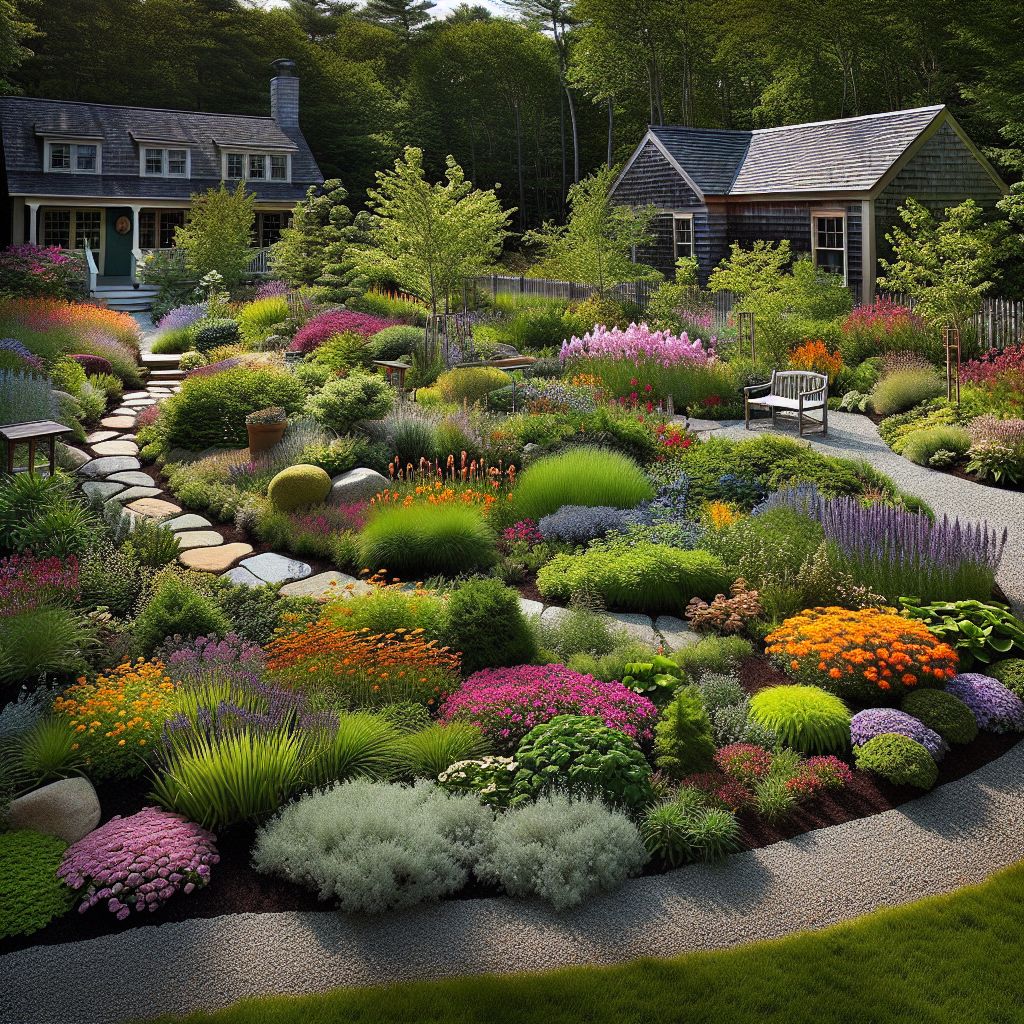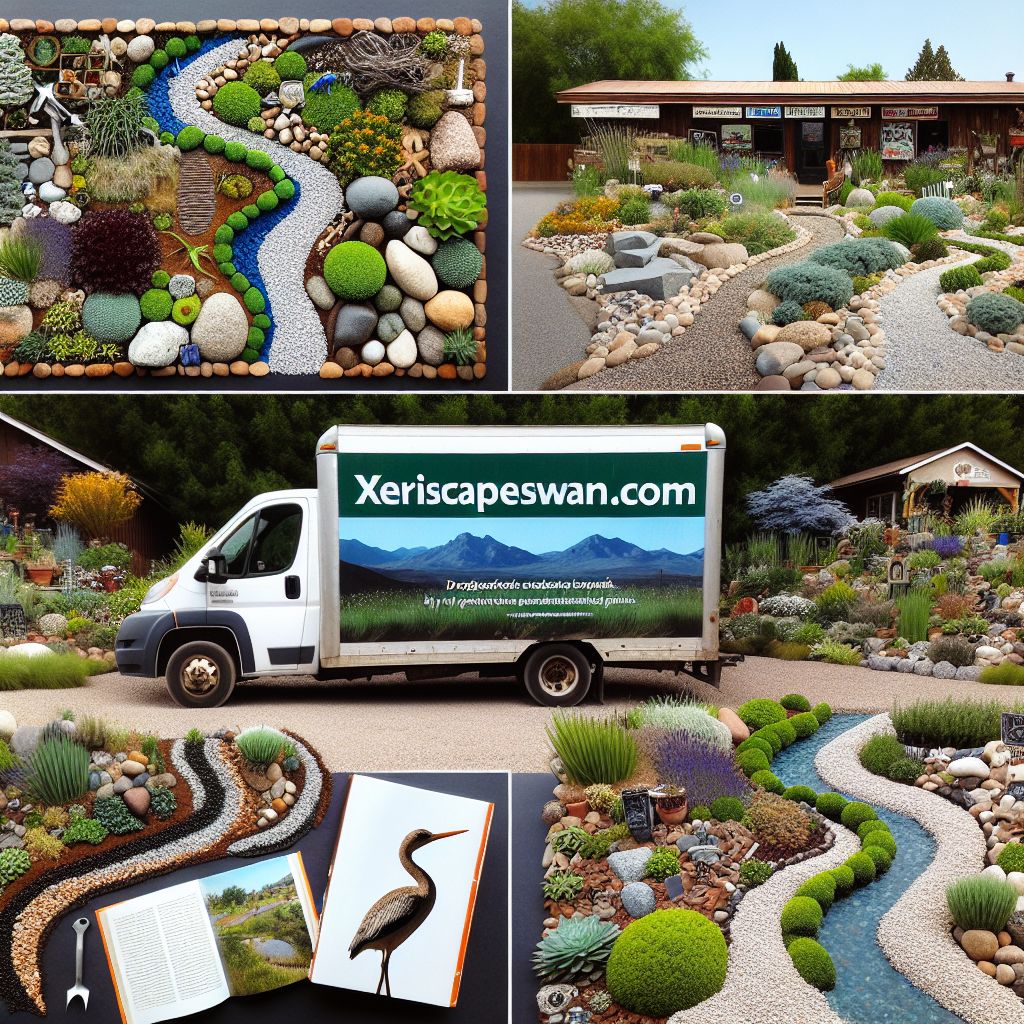
Key Takeaways
- Discover the beauty and benefits of
with native shrubs and flowering plants tailored to Massachusetts. - Learn how to design a sustainable, low-water front yard that thrives in New England’s climate.
- Get to know the best native plants for your xeriscape garden that are both water-wise and wildlife-friendly.
- Understand the cost-effectiveness of xeriscaping, from initial investment to long-term savings.
- Embrace easy maintenance tips for year-round care of your drought-tolerant landscape.
Transform Your Front Yard with Native Beauty
Imagine stepping outside to a front yard that’s not only a feast for the eyes but also a haven for local wildlife and a testament to sustainability. That’s the power of xeriscaping with native plants in Massachusetts. Here, we’re not just talking about a garden; we’re crafting an ecosystem that’s resilient, beautiful, and kind to our planet.
Low-Water Landscaping for New England Climate
Massachusetts’s climate can be a rollercoaster, with wet springs, humid summers, and frosty winters. Xeriscaping, which involves landscaping with plants that require minimal water beyond what nature provides, is a smart response to these conditions. It’s all about choosing plants that are in sync with local weather patterns and soil types.
Best Native Shrubs & Flowers to Elevate Your Garden
When we pick native shrubs and flowers for our gardens, we’re selecting plants that are already well-adapted to our local environment. This means they’re more likely to thrive with less fuss and fewer resources. They also offer a buffet of benefits for native birds, bees, and butterflies.
Why Go Xeriscape
So, why xeriscape? It’s simple. Xeriscaping is a proactive step towards a more sustainable lifestyle. It’s a way to conserve water, reduce your carbon footprint, and create a peaceful, natural space that requires less maintenance than traditional lawns.
Battling Water Scarcity With Style
Even in Massachusetts, where rainfall is relatively plentiful, water conservation is critical. By xeriscaping, you’re not just saving water; you’re crafting a landscape that can stand up to drought and water restrictions with grace and vigor.
The Eco-friendly Approach to Massachusetts Lawns
Xeriscaping is more than just a landscaping trend; it’s a movement towards more eco-friendly homes. By choosing plants that require fewer inputs like water, pesticides, and fertilizers, you’re making a choice that benefits the environment as a whole.
Designing Your Xeriscape Garden
Designing a xeriscape garden is like painting a picture with plants. You’ll want to consider colors, textures, and the mature size of each plant. But most importantly, you’ll focus on how these plants will interact with the local climate and ecosystem.
Planning Your Low-Maintenance Haven
Start with a plan. Sketch out your yard, noting areas of sun and shade, existing plants, and where you might want paths or features. Then, think about which native plants will fit those spots best. Remember, the goal is to work with nature, not against it.
Choosing Plants That Thrive in Your Local Climate
Picking the right plants is crucial. You’ll want species that are accustomed to Massachusetts’ weather and can handle its seasonal changes. Native plants are the best choice because they’ve evolved over millennia to thrive in local conditions without extra watering or care.
Top Picks for Massachusetts Xeriscaping
Let’s talk specifics. Here are some native plants that are perfect for Massachusetts xeriscapes:
- Bayberry (Myrica pensylvanica): This shrub offers fragrant foliage and waxy berries that birds love.
- Eastern Purple Coneflower (Echinacea purpurea): A magnet for butterflies and bees, it adds a splash of color.
- Switchgrass (Panicum virgatum): A grass that provides movement and texture to your garden.
- New England Aster (Symphyotrichum novae-angliae): Offers beautiful fall blooms and supports pollinators.
- Inkberry (Ilex glabra): An evergreen option that provides year-round interest.
These are just a few options. There are many more plants to explore, each with its own set of benefits for your xeriscape garden.
Native Shrubs That Save Water and Support Wildlife
Choosing native shrubs like Bayberry or Inkberry means you’re selecting plants that naturally conserve water. They’ve adapted to local rainfall patterns and often have deep root systems that make them drought-tolerant. Plus, they provide essential habitat and food for wildlife.
Blooms That Bring Color Without Guzzling Resources
Who says conservation can’t be colorful? Plants like the Eastern Purple Coneflower and New England Aster bring vibrant hues to your garden while being low on water needs. They’re living proof that eco-friendly gardens can be just as lush and inviting as traditional ones.
Creating a Cost-Effective Xeriscape
Transitioning to a xeriscape might seem like a big investment upfront, but let’s break down the numbers. Traditional lawns can guzzle thousands of gallons of water each year, especially during hot Massachusetts summers. By xeriscaping, you could save significantly on your water bill. For example, if you’re paying $4 for every 1,000 gallons and using 10,000 gallons a month to water your lawn, that’s $40 a month you could be saving. Over a year, that adds up to $480, and over five years, a whopping $2,400.
How Much Will You Save on Water Bills?
When you xeriscape, you’re not just saving money; you’re conserving a vital resource. It’s estimated that outdoor watering makes up about 30% of household water use. By choosing plants that require less water, you’re slashing that percentage dramatically. In the long run, you’ll notice a significant decrease in your water bills, a savings that will continue to grow year after year.
Breaking Down Initial Investment vs. Ongoing Savings
Yes, you’ll need to spend some money at the start. You’re investing in new plants, perhaps some hardscaping, and maybe even a new irrigation system designed for efficiency. However, these costs are often recouped within a few years thanks to lower water bills and reduced maintenance costs. After all, you won’t be spending money on fertilizers, lawnmowers, or lawn care services.
Year-Round Maintenance Made Easy
Maintenance is where xeriscaping really shines. Unlike traditional lawns, xeriscapes require minimal care. This means more time to enjoy your yard and less time working in it.
Once established, your xeriscape will thrive with just the occasional pruning and weeding. Plus, the need for watering is drastically reduced, if not eliminated altogether, thanks to the drought-resistant nature of the plants you’ve chosen.
Seasonal Upkeep Tips for Your Drought-Tolerant Garden
Even the hardiest plants need a little TLC to stay at their best. Here’s how to keep your xeriscape looking great all year round:
- In spring, tidy up any winter debris and add mulch to conserve moisture.
- Summer is all about enjoying your garden. Keep an eye on any new plants that might need a bit more water as they establish.
- Fall is the perfect time for planting new additions and dividing perennials.
- Winter is mostly hands-off, but protect any sensitive plants with extra mulch if needed.
Long-lasting Landscaping: Minimizing Effort for Maximum Beauty
A well-designed xeriscape is like a self-sustaining ecosystem. It requires so little from you because it’s made up of plants that are meant to be here. They’ve spent thousands of years adapting to Massachusetts’s climate, and they know how to survive and thrive with whatever Mother Nature throws at them.

Embracing the Desert Vibes
When you hear ‘xeriscape’, you might think of cacti and sand, but in Massachusetts, it’s about embracing the native landscape. It’s about creating a garden that reflects the natural beauty of New England’s diverse ecosystems.
Incorporating Elements of Desert Beauty Into New England
While we’re not in the desert, we can still borrow from its palette. Think of the warm tones of ornamental grasses, the rich greens of native shrubs, and the bright pops of color from wildflowers. All these elements can create a New England xeriscape that’s as stunning as any desert oasis.
By using plants like the drought-tolerant Bearberry or the resilient New England Aster, you’re getting that desert resilience without sacrificing the local charm.
Xeriscaping Beyond Cacti: Desert-like Options for Cooler Climates
Here are some plants that can give you that desert feel without needing a hot, arid climate: consider using sedum for xeriscaping, which thrives in low-water and high-sunlight gardens.
- Little Bluestem (Schizachyrium scoparium): This grass stands tall and turns a beautiful bronze in the fall.
- Butterfly Weed (Asclepias tuberosa): With its vibrant orange flowers, it’s a beacon for butterflies.
- Blue Vervain (Verbena hastata): This perennial brings height and a touch of blue-purple to your garden.
The Practical Side of Paradise
Now let’s get practical. Xeriscaping is about matching the right plants to your specific environment. This means considering the sun exposure, soil type, and even the slope of your land.
Plants like the drought-tolerant Sedum or the hardy Juniper are great for sunny spots, while the shade-tolerant Ferns and Foamflowers will thrive in cooler, shaded areas.
Water Needs: Keeping Thirst at Bay with Wise Choices
By choosing plants adapted to your area’s rainfall, you’re naturally reducing the need for supplemental watering. This is where native plants shine. They’re used to the local precipitation patterns and can often get by on that alone.
Sun and Soil: Matching Plants to Your Home’s Microclimate
Every yard has its own microclimate, and understanding yours is key to a successful xeriscape. Observe where the sun hits throughout the day, and note the areas that stay moist or dry out quickly. Match your plants to these conditions for a garden that practically takes care of itself. For more insight on selecting the right plants, check out this guide on xeriscaping with native plants.
Invest Wisely: Cost and Value of Xeriscaping
Investing in xeriscaping is a smart financial decision for homeowners. By reducing the need for regular watering, fertilizing, and mowing, you can save a considerable amount of money on your utility bills and lawn maintenance. These savings can be significant over time, providing a return on investment that makes the initial cost of transitioning to a xeriscape well worth it.
Moreover, xeriscaping can increase the value of your property. A well-designed, sustainable landscape can be a strong selling point for environmentally conscious buyers. The aesthetic appeal of a lush, low-water garden full of native plants can also enhance curb appeal, making your home stand out in the neighborhood.
Calculating the Price of Your Eco-Friendly Upgrade
When considering the price of converting your traditional lawn into a xeriscape, it’s important to factor in both the short-term and long-term costs. Initially, you’ll need to invest in the design, purchase of plants, and possibly new irrigation systems. However, the ongoing savings from reduced water usage, lower maintenance costs, and the potential increase in property value can offset these costs. For instance, if the average water bill for maintaining a lawn is around $40 per month, switching to a xeriscape that requires minimal watering could save you hundreds of dollars each year.
Future-Proofing Your Yard: Longevity and Resilience
Another financial benefit of xeriscaping is its longevity and resilience. Native plants used in xeriscaping are adapted to the local climate and are often more resistant to pests and diseases, which means less money spent on treatments and replacements. Furthermore, as climate patterns shift and water becomes an even more precious resource, having a landscape that requires minimal inputs will become increasingly valuable.
Local Touches For Massachusetts Xeriscapes
When adapting xeriscape principles to the Massachusetts climate, it’s essential to consider the local conditions such as weather patterns, soil types, and native plant species. By doing so, you ensure that your xeriscape garden is not only sustainable but also a reflection of the natural beauty of the region.
Adapting Xeriscape Principles to the Massachusetts Climate
The Massachusetts climate presents unique challenges for xeriscaping. The region experiences cold winters and hot, humid summers, which means selecting plants that can withstand a wide range of temperatures is crucial. Incorporating native plants that are used to these conditions will lead to a more resilient garden that requires less intervention to thrive.
Region-Specific Advice for Soil Prep and Plant Care
Proper soil preparation is key to successful xeriscaping in Massachusetts. Amending the soil with organic matter can improve drainage and nutrient content, making it more suitable for native plants. Additionally, mulching helps retain moisture and suppress weeds, further reducing the need for maintenance. Regular care for xeriscaped gardens is minimal, often involving occasional weeding and pruning to maintain shape and health.
Xeriscape Elements for Your Yard
To help you compare and choose the best plants for your xeriscape, here’s a quick reference table with some common options:
| Plant Type | Water Needs | Sunlight Requirements | Seasonal Interest |
|---|---|---|---|
| Bayberry (Myrica pensylvanica) | Low | Full sun to partial shade | Year-round, with fragrant leaves and berries |
| Eastern Purple Coneflower (Echinacea purpurea) | Low to moderate | Full sun | Summer blooms, attractive seed heads in fall |
| Switchgrass (Panicum virgatum) | Low | Full sun | Summer to winter, with ornamental seed heads |
| New England Aster (Symphyotrichum novae-angliae) | Low to moderate | Full sun to partial shade | Late summer to fall blooms |
| Inkberry (Ilex glabra) | Low to moderate | Full sun to partial shade | Year-round, with evergreen foliage and black berries |
Xeriscape Plant Comparison
This table provides a snapshot of various plants’ water needs, sunlight requirements, and the seasonal interest they offer. By comparing these factors, you can make informed decisions about which plants will work best in your xeriscape design.
Hardiness and Beauty: A Quick Reference
When choosing plants for your xeriscape, it’s important to consider both their hardiness and their aesthetic appeal. The plants listed in the table above are known for their ability to withstand Massachusetts’s climate while also providing visual interest throughout the year.
ere is a data table with 5 rows and 3 columns for the topic of Massachusetts Xeriscaping:
| Native Shrub | Description |
|---|---|
| Sweetbay Magnolia (Magnolia virginiana) | Can be grown as a tree or multi-stemmed shrub for privacy |
| Bearberry (Arctostaphylos uva-ursi) | A low-growing, spreading shrub that makes an excellent groundcover |
| Chokeberry (Aronia spp.) | Adaptable shrubs with showy spring flowers and fall foliage color |
| Fragrant Sumac (‘Gro-Low’ Rhus aromatica) | A spreading, low-growing shrub that is great for erosion control on slopes |
| Black-eyed Susan (Rudbeckia hirta) | An easy-to-grow, drought-tolerant wildflower that blooms heavily the first year from seed |
References:
https://www.massaudubon.org/our-conservation-work/ecological-management/habitat-management/native-plants/plant-database/plant/magnolia-virginiana
https://www.mass.gov/guides/native-plants-for-massachusetts-gardens
https://www.umassgreeninfo.org/fact_sheets/landscape_plants/native_shrubs.html
https://www.mass.gov/guides/creating-a-pollinator-garden https://www.umassgreeninfo.org/fact_sheets/landscape_plants/native_shrubs.html

Frequently Asked Questions (FAQ)
Can Xeriscaping Survive Harsh New England Winters?
Absolutely! Xeriscaping in Massachusetts is all about choosing plants that are native to the region and can naturally withstand the local climate, including harsh winters. These plants have adapted to survive the cold and will bounce back in the spring.
How Do I Start Converting My Traditional Lawn to a Xeriscape?
Begin by researching native plants and their needs. Then, gradually replace sections of your lawn with these plants, adding mulch and efficient irrigation systems as needed. It’s a process, so take it step by step and consult local xeriscaping resources for guidance.
Are There Any Incentives for Xeriscaping in Massachusetts?
Some municipalities offer incentives for water-wise landscaping to encourage conservation. Check with your local government or water utility company to see if they offer rebates or other incentives for xeriscaping.
What If I Want a Lawn – Can I Still Xeriscape?
Yes, you can incorporate xeriscaping principles into your lawn by selecting drought-tolerant grass species and reducing the lawn’s size with native plantings around the edges or in designated areas.
Can Xeriscaping Increase My Property Value?
Xeriscaping can indeed increase your property value. A well-designed xeriscape can improve curb appeal, reduce maintenance costs, and showcase a commitment to sustainability, all of which are attractive to potential buyers.




Leave a Reply